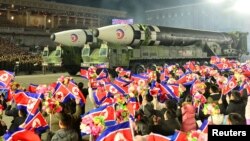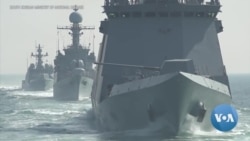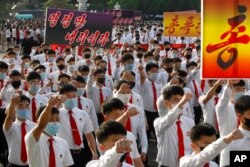Since 2022, North Korea has launched missiles at an unprecedented pace, as it rapidly expands a nuclear arsenal meant to threaten the United States and its allies. But during that buildup, Pyongyang has been less willing to lob rhetorical bombs at Washington.
That appears to be changing.
Over the last month, amid large-scale U.S.-South Korea military drills, North Korea’s tightly controlled state media have taken a more belligerent tone, amplifying violent expressions of anti-U.S. sentiment that are reminiscent of earlier periods of tension.
The harsher rhetoric has appeared in both international and domestic-facing outlets, which have reported on a series of government-led rallies in which young North Koreans are said to have turned out in droves to volunteer for military service.
According to the North’s Korean Central News Agency, about 1.4 million youth volunteered to join or rejoin North Korea’s military during a three-day period last month — showing the “unshakeable will of the younger generation to mercilessly wipe out the war maniacs,” according to KCNA.
State television coverage of the rallies has shown young people holding signs with expressions such as “let’s slice them into pieces,” “let’s beat them to a pulp,” and “rip them apart to death,” according to NK News, a Seoul-based online publication that focuses on North Korea.
The rhetoric is still tame by the standards of North Korean propagandists, who before 2018 frequently threatened during periods of tension to turn Seoul, or sometimes Washington, into a “sea of fire.”
But if the trend continues, analysts say it could signal the end of an extended period of rhetorical restraint during which North Korea was largely focused on internal challenges, such as the COVID-19 pandemic and related economic difficulties.
“The question is where all this is leading,” said Rachel Minyoung Lee, an analyst who closely monitors North Korean media.
The decision to use more aggressive language must have been made at a relatively senior level, Lee said, but whether it will be accompanied by a change of North Korea’s foreign and defense policies is less clear.
“They can talk tough, but it doesn’t necessarily translate into action,” said Lee, an analyst with the Vienna-based Open Nuclear Network.
Recent history
The last time North Korea deployed such an aggressive rhetorical approach was in 2017 — the so-called “fire and fury” period — when North Korean leader Kim Jong Un and former U.S. President Donald Trump exchanged frequent personal insults and threats of nuclear destruction.
Those tensions subsided in 2018, when Kim decided to hold a historic summit with Trump, as well as a series of separate meetings with his South Korean counterpart, President Moon Jae-in.
Kim eventually walked away from the talks, frustrated with Trump’s refusal to grant what he saw as sufficient concessions in exchange for partial steps to dismantle North Korea’s nuclear program.
Months later, North Korea entered an extended period of extreme isolation, sealing itself off from the rest of the world after COVID-19 emerged in neighboring China.
Even as North Korea dramatically increased its missile tests in recent years, its language toward Trump, and eventually his successor, U.S. President Joe Biden, was more measured.
But North Korea’s aggressive language has intensified, especially after South Korea’s new conservative president, Yoon Suk Yeol, adopted a tougher approach toward Pyongyang.
New level of tension?
Much of North Korea’s vitriol has focused on recent U.S.-South Korea military exercises, which have included regular and highly visible displays of the alliance’s vastly superior firepower.
In a rare move, Rodong Sinmun, North Korea’s main newspaper, recently published a pair of lengthy commentaries apparently meant to stir up anti-U.S. sentiment over the exercises.
One of the commentaries, published March 17, warned that “the U.S. and its vassal forces” were crossing an “intolerable red line” — a phrase increasingly used by state media.
The editorials, as well as the anti-U.S. rallies, raise the possibility that North Korea is preparing its population for a new level of tensions with the United States.
In the view of Michael Madden, who focuses on North Korean leadership at the Washington-based Stimson Center, the public demonstrations are especially notable.
“If the regime goes on a full throttle public affairs effort then things are a bit darker and dire than if they are just releasing government statements,” said Madden. “If observers are looking for an inflection point it will come with more public events and population mobilization.”
What Kim says matters
As analysts parse North Korean propaganda, Madden says it is important to distinguish between comments made by Kim and those made by lower-level officials, which often represent what he calls “tactical rhetoric.”
“If it comes from Kim Jong Un or is a read-out of a political event that he has attended, this is strategic rhetoric and gives us an accurate sense of Pyongyang's perspective,” he added.
In September, Kim’s government passed a law enshrining the right to use pre-emptive nuclear strikes. Since then, Kim has repeatedly mentioned the possibility of such an attack. But many of Kim’s comments also continue to stress what he sees as the deterrent or defensive nature of his nuclear weapons.
Kim’s approach may be partly motivated by a desire to have his country be seen as a responsible nuclear weapons-possessing state, according to Lee.
“But I think the larger part of it is that he wants to show the world that North Korea will translate the nuclear law into action if push comes to shove,” she said.















